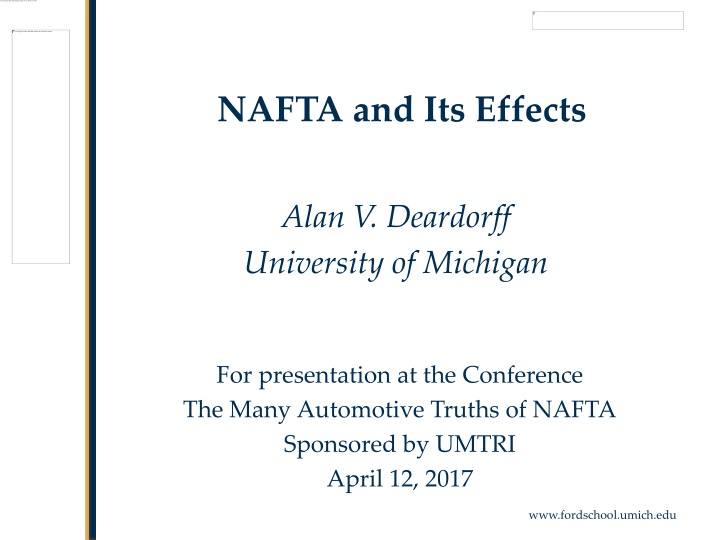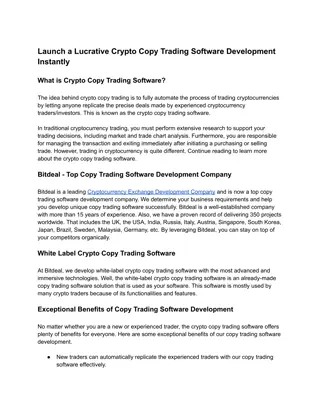
Effects of NAFTA on Trade: Analysis and Key Findings
Discover the impact of NAFTA on trade through economic analyses and data on trade growth, deficits, and key components of US-NAFTA trade. Explore the evolution of trade post-NAFTA and its effects on the US economy.
Download Presentation

Please find below an Image/Link to download the presentation.
The content on the website is provided AS IS for your information and personal use only. It may not be sold, licensed, or shared on other websites without obtaining consent from the author. If you encounter any issues during the download, it is possible that the publisher has removed the file from their server.
You are allowed to download the files provided on this website for personal or commercial use, subject to the condition that they are used lawfully. All files are the property of their respective owners.
The content on the website is provided AS IS for your information and personal use only. It may not be sold, licensed, or shared on other websites without obtaining consent from the author.
E N D
Presentation Transcript
NAFTA and Its Effects Alan V. Deardorff University of Michigan For presentation at the Conference The Many Automotive Truths of NAFTA Sponsored by UMTRI April 12, 2017 www.fordschool.umich.edu
NAFTA The single worst trade deal ever approved in this country - Donald J. Trump, candidate 2 www.fordschool.umich.edu
Ill look at Trade after NAFTA Economic analyses of NAFTA Renegotiating NAFTA 3 www.fordschool.umich.edu
Growth of Trade after NAFTA US-NAFTA trade doubled 1993-2000 World trade grew much less US-NAFTA trade grew more slowly after 2000 World trade took off after 2001 (China s entry to WTO) 4 www.fordschool.umich.edu
5 www.fordschool.umich.edu Source: Congressional Research Service (2015)
World Merchandise Trade $ trillion 25.00 20.00 15.00 10.00 5.00 0.00 1993 1994 1995 1996 1997 1998 1999 2000 2001 2002 2003 2004 2005 2006 2007 2008 2009 2010 2011 2012 2013 2014 2015 Source: WTO data 6 www.fordschool.umich.edu
US Trade Deficit after NAFTA Deficit with NAFTA partners grew From about zero in 1993 To $150 billion in 2008 Most of that was petroleum Non-petroleum deficit is now back to about zero 7 www.fordschool.umich.edu
8 www.fordschool.umich.edu Source: Congressional Research Service (2015)
9 www.fordschool.umich.edu Source: Congressional Research Service (2015)
Components of US-NAFTA Trade Largest imports are petroleum Largest exports are motor vehicle parts (also a major import) Motor vehicles are major import and (though smaller) export 10 www.fordschool.umich.edu
Source: Congressional Research Service (2015) 11 www.fordschool.umich.edu
Effects of NAFTA Analyses: Before Many studies examined likely effects Some, from both sides of the debate, used spurious analysis to support their views Example: All imports from Mexico are viewed as costing jobs On the positive side, advocates of NAFTA did the same with US exports, presumed to rise a lot because of Mexico s high tariffs 12 www.fordschool.umich.edu
Effects of NAFTA Analyses: Before Best academic studies (including our Michigan Model ) predicted Positive, but very small, benefit to the US Negligible disruption of US labor markets Positive, somewhat larger, benefit to Mexico Significant disruption in some Mexican markets Nobody predicted Peso Crisis 13 www.fordschool.umich.edu
Effects of NAFTA Analyses: Before Reasons for small predicted effects on US US MFN tariffs were already very low Much trade with Mexico was already at even lower tariffs, under Maquiladora system US trade with Mexico was big, but not all that big, compared to size of US economy 14 www.fordschool.umich.edu
Effects of NAFTA Analyses: Before The Main Issue that Raised Concern Mexican wages were only about 1/10 of US wages Seemed obvious to many (e.g., Ross Perot) that employers would move to Mexico Answer Mexican wages were low for a reason: low productivity If this had not been true, jobs would already have moved, given our already low tariffs 15 www.fordschool.umich.edu
Effects of NAFTA Analyses: After Romalis (2005) Welfare effects close to zero for US, Canada, and Mexico Caliendo and Parro (2015) Updated earlier studies with more recent analytical tools Found Welfare benefits for US and Mexico, but Welfare loss for Canada 16 www.fordschool.umich.edu
Welfare effects from NAFTAs tariff reductions Welfare Terms of Trade Volume of Trade Country Total Real Wages Mexico 1.31% 0.41% 1.72% 1.72% Canada 0.06% 0.11% 0.04% 0.32% U.S. 0.08% 0.04% 0.04% 0.11% Source: Caliendo and Parro (2015), Table 2 17 www.fordschool.umich.edu
Effects of NAFTA Analyses: After Posen (2014) For every 100 jobs US manufacturers created in Mexican manufacturing, they added nearly 250 jobs at their larger US home operations Unemployment in US was actually lower after NAFTA than before (until the 2008 financial crisis) Critics say NAFTA cost 45,000 jobs a year. That may be true But this is only 0.1% of normal job turnover in the US, where 4m-6m workers leave or lose jobs per month) 18 www.fordschool.umich.edu
Effects of NAFTA Analyses: After Hakobyan and McLaren (2016) They look for effects on local labor markets, where industries and/or communities were vulnerable to large tariff cuts against Mexico They find Substantial variation across localities 19 www.fordschool.umich.edu
Source: Hakobyan and McLaren (2016) 20 www.fordschool.umich.edu
Source: Hakobyan and McLaren (2016) 21 www.fordschool.umich.edu
(Consistent Public-Use Microdata Areas) 22 www.fordschool.umich.edu Source: Hakobyan and McLaren (2016)
Effects of NAFTA Analyses: After Hakobyan and McLaren (2016) The fact that both the location and the industry effects hit blue-collar workers, especially high school dropouts, but not college graduates suggests the possibility that the costs of moving or of switching industries are larger for less educated workers, so that more educated workers can adjust more easily and arbitrage wage differences away. 23 www.fordschool.umich.edu
Effects of NAFTA Analyses: After Hakobyan and McLaren (2016) even workers in a nontraded industry waiting on tables in a diner, for example saw a sharp reduction in wages if they were in a vulnerable location that lost its protection quickly. 24 www.fordschool.umich.edu
Effects of NAFTA Analyses: After Disruption of some industries and localities Was expected May have been larger than expected Has not been dealt with adequately by TAA Nonetheless was still small But provides easy ammunition for critics 25 www.fordschool.umich.edu
Renegotiating NAFTA Donald Trump said he would either Pull out of NAFTA, or Renegotiate NAFTA 26 www.fordschool.umich.edu
Renegotiating NAFTA Nov 21, 2016: Feb 1, 2017: Mar 30, 2017: 27 www.fordschool.umich.edu
Renegotiating NAFTA The modest changes : Snapback tariffs Changes in Rules of Origin Permit Buy American in government procurement Several features that were part of TPP Protection of digital trade Tougher intellectual property enforcement Requirements on state-owned enterprises Labor and environment provisions Does not mention currencies www.fordschool.umich.edu
Renegotiating NAFTA April 11, 2017: In a meeting with company executives Tuesday morning, Trump promised more progress on the talks. "We re going to have some very pleasant surprises for you on NAFTA," he said. www.fordschool.umich.edu






















